Effective and Unsupervised Fractal-based Feature Selection for Very Large Datasets: removing linear and non-linear attribute correlations
- 1. Effective and Unsupervised Fractal-based Feature Selection for Very Large Datasets Removing linear and non-linear attribute correlations Antonio Canabrava Fraideinberze Jose F Rodrigues-Jr Robson Leonardo Ferreira Cordeiro Databases and Images Group University of São Paulo São Carlos - SP - Brazil
- 2. 2 Terabytes? … How to analyze that data?
- 3. 3 Terabytes? Parallel processing and dimensionality reduction, for sure... … How to analyze that data?
- 4. How to analyze that data? 4 Terabytes? , but how to remove linear and non-linear attribute correlations, besides irrelevant attributes? …
- 5. How to analyze that data? 5 Terabytes? , and how to reduce dimensionality without human supervision and being task independent? …
- 7. Agenda Fundamental Concepts Related Work Proposed Method Evaluation Conclusion 7
- 8. Agenda Fundamental Concepts Related Work Proposed Method Evaluation Conclusion 8
- 13. Fundamental Concepts Fractal Theory Embedded, Intrinsic and Fractal Correlation Dimension Fractal Correlation Dimension ≅ Intrinsic Dimension 13
- 14. Fundamental Concepts Fractal Theory Embedded, Intrinsic and Fractal Correlation Dimension Embedded dimension ≅ 3 Intrinsic dimension ≅ 1 Embedded dimension ≅ 3 Intrinsic dimension ≅ 2 14
- 15. Fundamental Concepts Fractal Theory Fractal Correlation Dimension - Box Counting 15
- 16. Fundamental Concepts Fractal Theory Fractal Correlation Dimension - Box Counting 16
- 17. Fundamental Concepts Fractal Theory Fractal Correlation Dimension - Box Counting log(r) 17
- 18. Fundamental Concepts Fractal Theory Fractal Correlation Dimension - Box Counting log(r) 18
- 19. Fundamental Concepts Fractal Theory Fractal Correlation Dimension - Box Counting 19 Multidimensional Quad-tree [Traina Jr. et al, 2000]
- 20. Agenda Fundamental Concepts Related Work Proposed Method Evaluation Conclusion 20
- 21. Related Work Dimensionality Reduction - Taxonomy 1 Dimensionality Reduction Supervised Algorithms Unsupervised Algorithms Principal Component Analysis Singular Vector Decomposition Fractal Dimension Reduction 21
- 22. Related Work Dimensionality Reduction - Taxonomy 2 Dimensionality Reduction Feature ExtractionFeature Selection Principal Component Analysis Singular Vector Decomposition Fractal Dimension Reduction EmbeddedFilterWrapper 22
- 23. Related Work 23 Terabytes? Existing methods need supervision, miss non-linear correlations, cannot handle Big Data or work for classification only …
- 24. Agenda Fundamental Concepts Related Work Proposed Method Evaluation Conclusion 24
- 25. General Idea 25 Removes the E - ⌈D2⌉ least relevant attributes, one at a time in ascending order of relevance.
- 26. General Idea 26 Removes the E - ⌈D2⌉ least relevant attributes, one at a time in ascending order of relevance. Builds partial trees for the full dataset and for its E (E-1)-dimensional projections
- 27. General Idea 27 Removes the E - ⌈D2⌉ least relevant attributes, one at a time in ascending order of relevance. TreeID + cell spatial position Partial count of points
- 28. General Idea 28 Removes the E - ⌈D2⌉ least relevant attributes, one at a time in ascending order of relevance. Sums partial point counts and reports log(r) and log(sum2) for each tree
- 29. General Idea 29 Removes the E - ⌈D2⌉ least relevant attributes, one at a time in ascending order of relevance. Computes D2 for the full dataset and pD2 for each of its E (E-1)-dimensional projections
- 30. General Idea 30 Removes the E - ⌈D2⌉ least relevant attributes, one at a time in ascending order of relevance. The least relevant attribute, i.e., the one not in the projection that minimizes | D2 - pD2 |
- 31. General Idea 31 Removes the E - ⌈D2⌉ least relevant attributes, one at a time in ascending order of relevance. Spots the second least relevant attribute …
- 32. General Idea 3 Main Issues 32 Removes the E - ⌈D2⌉ least relevant attributes, one at a time in ascending order of relevance.
- 33. General Idea 3 Main Issues 33 Removes the E - ⌈D2⌉ least relevant attributes, one at a time in ascending order of relevance. 1° Too much data to be shuffled – one data pair per cell/tree
- 34. General Idea 3 Main Issues 34 Removes the E - ⌈D2⌉ least relevant attributes, one at a time in ascending order of relevance. 2° One data pass per irrelevant attribute
- 35. General Idea 3 Main Issues 35 Removes the E - ⌈D2⌉ least relevant attributes, one at a time in ascending order of relevance. 3° Not enough memory for mappers
- 36. Proposed Method Curl-Remover 36 1° Issue - Too much data to be shuffled; one data pair per cell/tree; Our solution - Two-phase dimensionality reduction: a) Serial feature selection in a tiny data sample (one reducer). Used to speed-up processing only; b) All mappers project data into a fixed subspace
- 37. 37 Removes the E - ⌈D2⌉ least relevant attributes, one at a time in ascending order of relevance.Builds/reports N (2 or 3) tree levels of lowest resolution… Proposed Method Curl-Remover
- 38. 38 Removes the E - ⌈D2⌉ least relevant attributes, one at a time in ascending order of relevance. … plus the points projected into the M (2 or 3) most relevant attributes of sample Proposed Method Curl-Remover
- 39. 39 Removes the E - ⌈D2⌉ least relevant attributes, one at a time in ascending order of relevance. Builds the full trees from their low resolution level cells and the projected points Proposed Method Curl-Remover
- 40. 40 Removes the E - ⌈D2⌉ least relevant attributes, one at a time in ascending order of relevance. Proposed Method Curl-Remover High resolution cells are never shuffled
- 41. Proposed Method Curl-Remover 41 2° Issue - One data pass per irrelevant attribute; Our solution – Stores/reads the tree level of highest resolution, instead of the original data.
- 42. 42 Removes the E - ⌈D2⌉ least relevant attributes, one at a time in ascending order of relevance. Rdb = cost to read dataset; TWRtree = cost to transfer, write and read the last tree level in next reduce step; If (Rdb > TWRtree) then writes tree; Proposed Method Curl-Remover
- 43. 43 Removes the E - ⌈D2⌉ least relevant attributes, one at a time in ascending order of relevance. Proposed Method Curl-Remover
- 44. 44 Removes the E - ⌈D2⌉ least relevant attributes, one at a time in ascending order of relevance. Writes tree’s last level in HDFS Proposed Method Curl-Remover
- 45. 45 Removes the E - ⌈D2⌉ least relevant attributes, one at a time in ascending order of relevance. Reads tree’s last level from HDFS Proposed Method Curl-Remover
- 46. 46 Removes the E - ⌈D2⌉ least relevant attributes, one at a time in ascending order of relevance. Proposed Method Curl-Remover Reads dataset only twice
- 47. Proposed Method Curl-Remover 47 3° Issue - Not enough memory for mappers; Our solution – Sorts data in mappers and reports “tree slices” whenever needed.
- 48. 48 Removes the E - ⌈D2⌉ least relevant attributes, one at a time in ascending order of relevance. Sorts its local points and builds “tree slices” monitoring memory consumption Proposed Method Curl-Remover
- 50. Proposed Method Curl-Remover 50 Reports “tree slices” with very little overlap
- 51. Agenda Fundamental Concepts Related Work Proposed Method Evaluation Conclusion 51
- 52. Evaluation Datasets Sierpinski - Sierpinski Triangle + 1 attribute linearly correlated + 2 attributes non- linearly correlated. 5 attributes, 1.1 billion points; Sierpinski Hybrid - Sierpinski Triangle + 1 attribute non-linearly correlated + 2 random attributes. 5 attributes, 1.1 billion points; Yahoo! Network Flows - communication patterns between end-users in the web. 12 attributes, 562 million points; Astro - high-resolution cosmological simulation. 6 attributes, 1 billion points; Hepmass - physics-related dataset with particles of unknown mass. 28 attributes, 10.5 million points; Hepmass Duplicated – Hepmass + 28 correlated attributes. 56 attributes, 10.5 million points. 52
- 55. Evaluation Comparison with sPCA - Classification 55
- 56. Evaluation Comparison with sPCA - Classification 56 8% more accurate, 7.5% faster
- 57. Evaluation Comparison with sPCA Percentage of Fractal Dimension after selection 57
- 58. Agenda Fundamental Concepts Related Work Proposed Method Evaluation Conclusion 58
- 59. Conclusions Accuracy - eliminates both linear and non-linear attribute correlations, besides irrelevant attributes; 8% better than sPCA; Scalability – linear scalability on the data size (theoretical analysis); experiments with up to 1.1 billion points; Unsupervised - it does not require the user to guess the number of attributes to be removed neither requires a training set; Semantics - it is a feature selection method, thus maintaining the semantics of the attributes; Generality - it suits for analytical tasks in general, and not only for classification; 59
- 60. Conclusions Accuracy - eliminates both linear and non-linear attribute correlations, besides irrelevant attributes; 8% better than sPCA; Scalability – linear scalability on the data size (theoretical analysis); experiments with up to 1.1 billion points; Unsupervised - it does not require the user to guess the number of attributes to be removed neither requires a training set; Semantics - it is a feature selection method, thus maintaining the semantics of the attributes; Generality - it suits for analytical tasks in general, and not only for classification; 60
- 61. Conclusions Accuracy - eliminates both linear and non-linear attribute correlations, besides irrelevant attributes; 8% better than sPCA; Scalability – linear scalability on the data size (theoretical analysis); experiments with up to 1.1 billion points; Unsupervised - it does not require the user to guess the number of attributes to be removed neither requires a training set; Semantics - it is a feature selection method, thus maintaining the semantics of the attributes; Generality - it suits for analytical tasks in general, and not only for classification; 61
- 62. Conclusions Accuracy - eliminates both linear and non-linear attribute correlations, besides irrelevant attributes; 8% better than sPCA; Scalability – linear scalability on the data size (theoretical analysis); experiments with up to 1.1 billion points; Unsupervised - it does not require the user to guess the number of attributes to be removed neither requires a training set; Semantics - it is a feature selection method, thus maintaining the semantics of the attributes; Generality - it suits for analytical tasks in general, and not only for classification; 62
- 63. Conclusions Accuracy - eliminates both linear and non-linear attribute correlations, besides irrelevant attributes; 8% better than sPCA; Scalability – linear scalability on the data size (theoretical analysis); experiments with up to 1.1 billion points; Unsupervised - it does not require the user to guess the number of attributes to be removed neither requires a training set; Semantics - it is a feature selection method, thus maintaining the semantics of the attributes; Generality - it suits for analytical tasks in general, and not only for classification; 63


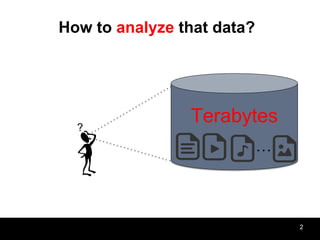
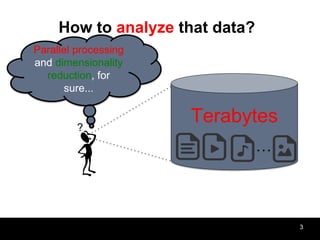
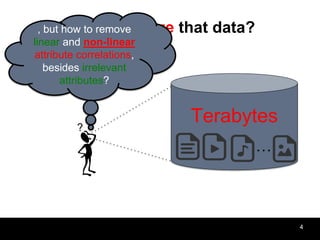



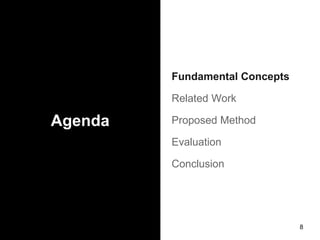

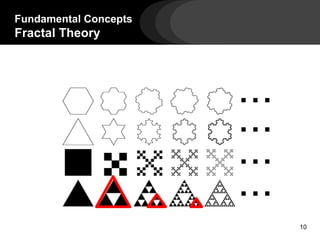








![Fundamental Concepts
Fractal Theory
Fractal Correlation Dimension - Box Counting
19
Multidimensional
Quad-tree
[Traina Jr. et al, 2000]](https://image.slidesharecdn.com/presentation-170127123347/85/Effective-and-Unsupervised-Fractal-based-Feature-Selection-for-Very-Large-Datasets-removing-linear-and-non-linear-attribute-correlations-19-320.jpg)












































